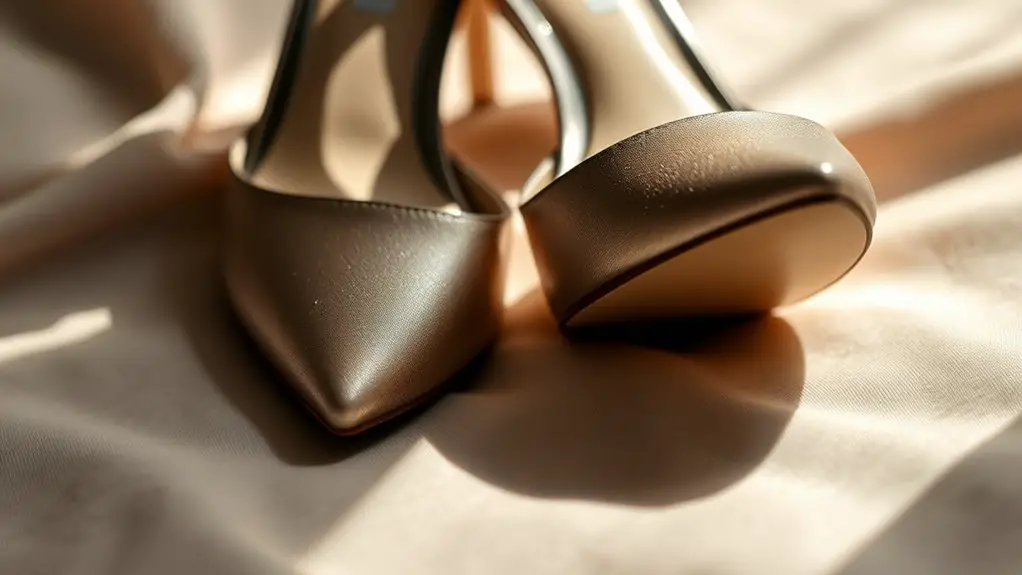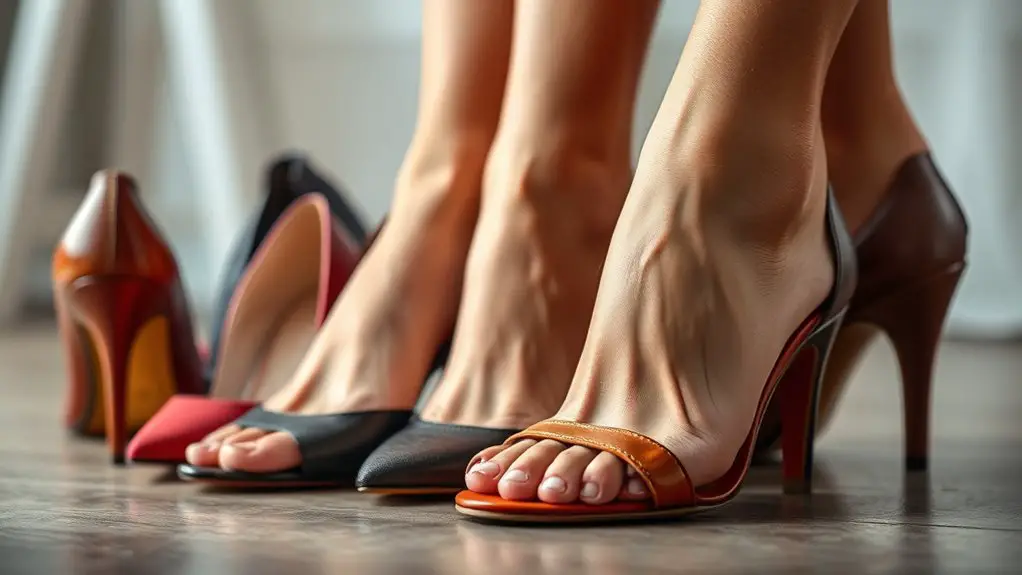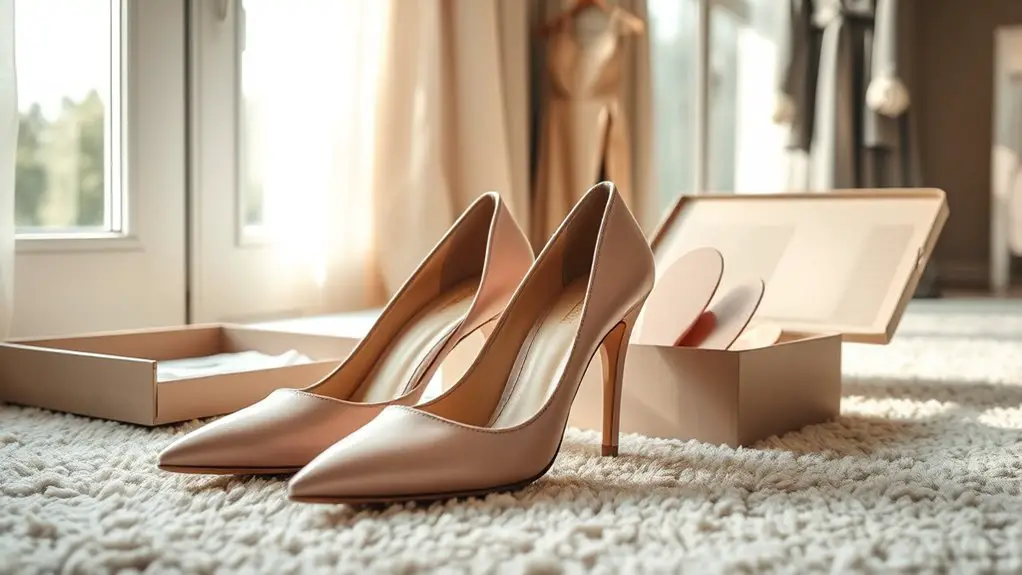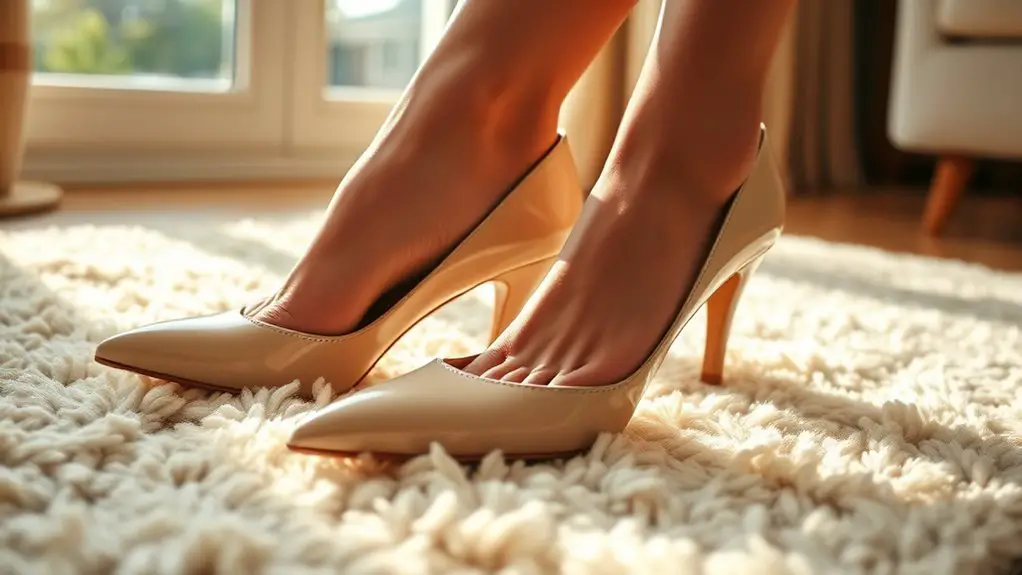To find heels that won’t pinch your toes, start by considering foot anatomy and guarantee the proper fit. Look for styles with wider toe boxes and round or almond shapes to avoid constriction. Opt for lower heel heights for better stability, and choose materials like leather or cushioned insoles for added comfort. Remember to assess the arch support as well. Explore options that prioritize your comfort; you’ll find even more strategies to enhance your shoe experience.
Understanding Foot Anatomy and Heel Fit

Understanding the nuances of foot anatomy is essential when it comes to finding comfortable heels. Your foot structure plays a significant role in determining how well a heel fits you. The bones, ligaments, and muscles work together to support your weight, and any misalignment can lead to discomfort. Heel anatomy is particularly important; the height, shape, and width of the heel can greatly impact how your foot feels while wearing them.
When shopping for heels, consider how the heel’s design interacts with your unique foot shape. A wider toe box may accommodate your foot better, while arch support can alleviate pressure points. Pay attention to the heel’s pitch, as a steeper angle can strain your foot. Understanding these elements will empower you to make informed choices, ensuring that your heels not only look great but feel great too. Prioritize comfort, and your feet will thank you.
Choosing the Right Heel Height
When choosing the right heel height, it’s crucial to take into account your comfort level first and foremost. Think about the occasion and how long you’ll be wearing the heels, as this can greatly influence your comfort throughout the day. Finally, don’t hesitate to test different heights to find what feels best for both your feet and your style.
Consider Your Comfort Level
How do you determine the right heel height for your needs? It’s essential to balance style with comfort, especially if you have foot sensitivity. Your personal preference will play a significant role, but consider these factors:
- Heel Height: Low heels (1-2 inches) offer more stability and comfort, ideal for prolonged wear.
- Arch Support: A slight elevation can help distribute weight evenly, reducing pressure on sensitive areas.
- Foot Shape: Different heel heights can accentuate or minimize discomfort based on your foot’s unique shape and sensitivity.
Assess Occasion and Duration
Choosing the right heel height isn’t just about personal comfort; it also hinges on the occasion and the duration you’ll be wearing them. Consider the event type—formal occasions may call for higher heels to elevate your look, while casual outings often allow for lower options.
Here’s a quick guide to help you decide:
| Event Type | Duration Considerations |
|---|---|
| Wedding | 4+ hours: lower heels |
| Office | 6+ hours: mid-height |
| Evening Out | 2-3 hours: higher heels |
Test Different Heights
While it may seem tempting to grab the highest heels on the shelf for that extra lift, it is essential to test different heights to find what truly works for you. Consider these three factors when selecting your heel height:
- Low Heels (1-2 inches): Great for everyday use, offering excellent toe comfort and stability, guaranteeing you won’t feel fatigued.
- Mid Heels (2-3 inches): Strikes a balance between elegance and comfort, providing decent heel stability while still allowing for some height.
- High Heels (3-4 inches and above): Perfect for special occasions, but make sure you prioritize toe comfort; be prepared for less heel stability.
Finding the right height will help you look fabulous without sacrificing comfort. Test them out and see what feels best for your feet!
Material Matters: Finding Comfortable Fabrics
When it comes to finding comfortable heels, the choice of fabric can considerably impact your overall experience. Selecting the right fabric types is essential for ensuring breathability and comfort, especially during extended wear. Here’s a quick guide to help you choose wisely:
| Fabric Type | Comfort Level |
|---|---|
| Leather | High |
| Suede | Moderate |
| Canvas | High |
| Synthetic Leather | Variable |
| Mesh | Very High |
Leather offers durability and a snug fit, while suede provides a softer touch. Canvas is lightweight and breathable, making it ideal for warmer weather. Synthetic leather can vary; some may feel stiff and uncomfortable, while others can be surprisingly soft. Finally, mesh is excellent for ventilation, reducing moisture and heat. Prioritize breathable materials to keep your feet happy and comfortable throughout the day.
Exploring Different Toe Shapes and Styles

Understanding the impact of toe shapes and styles can greatly enhance your comfort in heels. Choosing the right toe box can make all the difference, especially when combined with a suitable heel shape. Here are three popular toe shapes to reflect upon:
- Pointed Toe: This design elongates the foot, but can feel constricting. Confirm the toe box isn’t too narrow to avoid pinching.
- Round Toe: Offering more space, this style provides ample room for your toes, making it ideal for extended wear.
- Square Toe: With a wider toe box, square-toed heels allow for a comfortable fit, perfect for those who need extra room.
When selecting your heels, pay attention to how the toe box aligns with the heel shape. A well-balanced combination will keep your feet comfortable and pain-free, allowing you to enjoy your stylish footwear without the pinch.
The Importance of Arch Support
When selecting comfortable heels, arch support is essential for your foot health and overall comfort. Proper arch support helps distribute your weight evenly, reducing strain on your feet and preventing fatigue. To find the right fit, consider styles that offer built-in arch support or use orthotic inserts tailored to your foot’s unique needs.
Benefits of Arch Support
Although many may overlook the significance of arch support in footwear, it plays an essential role in maintaining overall foot health and comfort. Understanding your arch types and the support benefits they offer can dramatically enhance your footwear experience. Here are three key advantages of proper arch support:
- Pain Reduction: Proper support alleviates discomfort in the feet, knees, and lower back, making long hours in heels more bearable.
- Enhanced Stability: Good arch support improves balance, reducing the risk of slips and falls, especially on uneven surfaces.
- Increased Endurance: With better support, you can enjoy prolonged wear without fatigue, allowing you to stay stylish and comfortable throughout the day.
Investing in heels with the right arch support is vital for your foot health.
Choosing the Right Fit
Finding the right fit in heels is essential, as it directly impacts your comfort and overall foot health. To achieve this, you should start by taking accurate foot measurements, including length and width. Remember, your foot size can change over time, so measure regularly. Pay special attention to heel width; a snug fit prevents slipping but shouldn’t squeeze your foot. Additionally, consider arch support, as it helps distribute weight evenly, reducing pressure on the balls of your feet. When trying on heels, walk around to guarantee they fit well and provide the necessary support. If you experience any discomfort, it’s a sign that you may need a different size or style. Prioritize comfort to enjoy your heels without pain.
Tips for Breaking in New Heels

Breaking in new heels can be an intimidating task, especially if you’re keen to wear them for an event. To ease the process, consider these tips for a more comfortable experience:
Breaking in new heels can feel daunting, but with a few simple tips, you can ensure comfort for your special occasion.
- Start Slow: Wear your heels around the house for short periods. This will allow the material to stretch and adapt to your foot shape while testing heel flexibility.
- Cushioning Options: Invest in gel inserts or padded insoles. These cushioning options can greatly reduce pressure on your toes, making it easier to walk without discomfort.
- Use a Hairdryer: Lightly warm the areas that feel tight while wearing thick socks. This will help the material soften and mold to your foot for a better fit.
Recommended Brands for Comfortable Heels
When it comes to selecting comfortable heels, knowing which brands prioritize both style and support can make all the difference in your experience. Brands like Clarks and Naturalizer are renowned for their focus on comfort, offering cushioned insoles and arch support without sacrificing style. If you lean towards a more fashion-forward look, you might want to check out Cole Haan or Vionic, which blend trendy designs with innovative comfort technology.
For those who prefer a wider fit, brand comparisons show that Ecco and Dansko excel in providing roomy options that don’t compromise aesthetic appeal. Don’t forget to take into account your unique style preferences; some brands cater to more classic tastes, while others embrace contemporary designs. By exploring these options, you can find heels that not only look great but also keep your feet happy throughout the day.
Frequently Asked Questions
How Can I Tell if My Heels Are Too Tight?
To tell if your heels are too tight, pay attention to any toe discomfort during wear. A proper shoe fitting should allow for slight wiggle room, ensuring comfort without pinching or constricting your toes.
What Should I Do if My Heels Start to Pinch?
If your heels start to pinch like a vice, don’t panic. Try toe stretching exercises and consider using heel padding to ease discomfort. Your feet deserve comfort, so take action before it escalates!
Are Wide-Fit Heels Available for All Styles?
Wide-fit heels are available in various styles, offering stylish alternatives for those needing extra room. You’ll find options ranging from casual to dressy, ensuring you can look great without sacrificing comfort or fit.
Can Insoles Help Alleviate Toe Pinching in Heels?
“When the shoe fits, wear it!” Insoles can greatly enhance comfort in various heel types, providing benefits like cushioning and arch support that alleviate toe pinching. Consider investing in quality insoles for a better fit.
How Often Should I Replace My Heels for Comfort?
You should replace your heels every 6-12 months, depending on their heel lifespan and comfort factors. Regular wear can lead to decreased support and structure, impacting your overall foot comfort and health considerably.



